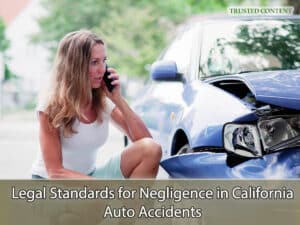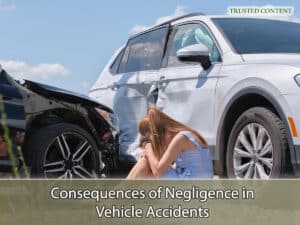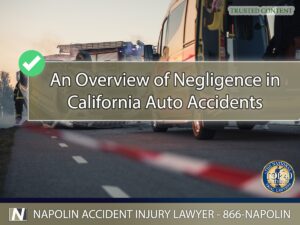An Overview of Negligence in California Auto Accidents
California's bustling roadways are notorious for traffic and, unfortunately, accidents. Auto accidents often lead to complex legal battles centered around the concept of negligence. Understanding your rights and legal options is crucial, especially when injuries are involved. This article delves into the legal framework of negligence as it applies to auto accidents in California, providing vital information for anyone affected by such incidents in southern California.
Understanding Negligence
In legal terms, negligence is the failure to take reasonable care to avoid causing injury or loss to another person. In the context of auto accidents, this means a driver is considered negligent if they fail to act with the caution that a reasonable person would exercise under the same circumstances. For a claim to be successful, four key components must be proven:
- Duty: The defendant owed a legal duty to the plaintiff.
- Breach: The defendant breached that duty through their action or inaction.
- Causation: The defendant's action or inaction caused the plaintiff's injuries.
- Damages: The plaintiff suffered measurable damage due to the defendant's breach.
Common Forms of Driver Negligence
Driver negligence can manifest in various forms, each potentially hazardous to other road users. Some of the most common negligent behaviors include:
- Distracted driving, such as using a mobile phone while driving
- Speeding, often exceeding posted limits or driving too fast for conditions
- Failure to yield the right of way
- Ignoring traffic signs or signals
- Driving under the influence of alcohol or drugs
These actions not only increase the risk of causing an accident but also affect a driver's liability in the event of a collision. Understanding these common forms of negligence can help victims identify when they may have a legal claim following an accident.

Legal Standards for Negligence in California Auto Accidents
Legal Standards for Negligence in California Auto Accidents
California law requires drivers to exercise “reasonable care under the circumstances.” This standard is somewhat subjective, allowing room for various interpretations based on specific case details. In the eyes of the law, reasonable care might include:
- Observing speed limits and road conditions
- Maintaining control of the vehicle
- Using turn signals and observing right-of-way rules
- Being vigilant of surrounding obstacles or hazards
Judgments in negligence cases often hinge on whether a reasonable person in the same situation would have acted differently than the defendant did. This is crucial in determining liability and assessing damages.
Comparative Negligence in California
California follows a “pure comparative negligence” rule, which allows a damaged party to recover even if they are 99% at fault, although their recovery is reduced by their degree of fault. This means that in an auto accident, both parties can bear some percentage of the blame. For instance, if one driver is found to be 70% responsible for an accident and the other 30%, the latter can still recover 70% of their total damages from the other party.
This approach underscores the importance of thorough legal representation to ensure that all aspects of negligence are properly argued and substantiated in court, particularly in complex cases where multiple parties may share fault.

Consequences of Negligence in Vehicle Accidents
Consequences of Negligence in Vehicle Accidents
Types of Damages Recoverable
In California, victims of auto accidents caused by negligence can pursue compensation for various types of damages. These damages are generally categorized into three main types:
- Economic Damages: Cover quantifiable losses such as medical expenses, lost wages, and property damage.
- Non-Economic Damages: Include compensation for pain and suffering, emotional distress, and loss of enjoyment of life.
- Punitive Damages: Awarded in cases of egregious wrongdoing to punish the negligent party and deter similar future conduct.
The objective of awarding damages is to restore the injured party to the financial position they would have been in had the accident not occurred. Legal expertise can be crucial in accurately valuing and claiming these damages.
Statute of Limitations for Filing an Auto Accident Claim in California
Under California law, there is a specific time frame within which a negligence claim must be filed, known as the statute of limitations. Generally, auto accident claims must be filed within two years from the date of the accident. Failing to adhere to this deadline typically results in the loss of the right to sue for damages. This makes it imperative for victims to seek legal counsel promptly to ensure their rights are protected.
Special Considerations in Negligence Cases
Handling a negligence case requires careful consideration of various elements, particularly in gathering and presenting evidence. Important aspects include:
- Police Reports: Often provide a preliminary assessment of fault and details of the accident scene.
- Witness Statements: Can offer crucial insights into the circumstances of the accident.
- Expert Testimony: Professionals such as accident reconstruction experts may be needed to establish the specifics of how the negligence occurred.

An Overview of Negligence in California Auto Accidents
An Overview of Negligence in California Auto Accidents
Auto accidents in southern California can have devastating effects on the lives of those involved. If you believe your accident was the result of another's negligence, it is crucial to understand your legal rights and options. At Napolin Accident Injury Lawyer, we bring extensive litigation experience to vigorously represent our clients and help them secure the compensation they deserve.
If you or a loved one has been injured in an auto accident in southern California, do not hesitate to reach out. Call us today at (866)-NAPOLIN to schedule your free consultation. Our dedicated team is committed to providing personalized legal representation, aiming to alleviate the burden during this challenging time and maximize your recovery. Remember, acting promptly can be decisive in protecting your legal rights and obtaining just compensation.
- Understanding Uber Accidents and Insurance Coverage Periods in California - April 8, 2025
- A Guide on Red Light Auto Accidents in California - August 14, 2024
- Self-Representing in a California Personal Injury Claim - August 13, 2024
